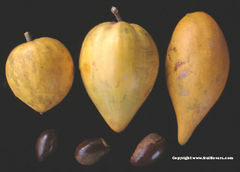Pouteria campechiana: Difference between revisions
No edit summary |
No edit summary |
||
| (One intermediate revision by one other user not shown) | |||
| Line 1: | Line 1: | ||
{{ | {{SPlantbox | ||
| | |familia=Sapotaceae | ||
| | |genus=Pouteria | ||
| | |species=campechiana | ||
| | |Min ht metric=cm | ||
| | |Temp Metric=°F | ||
| | |image=Eggfruit3Types-fruitlovers.jpg | ||
|image_width=240 | |||
| | |||
}} | }} | ||
The '''Canistel''' (''Pouteria campechiana'') is an evergreen [[tree]] native to southern [[Mexico]] and [[Central America]]. It is cultivated in other countries, such as [[Brazil]], [[Taiwan]], and [[Vietnam]]. Its [[binomial name]] is derived from the Mexican town of [[Campeche, Campeche|Campeche]], where it is native. It is sometimes (wrongly) referred to as ''Lucuma campechiana''. | |||
The | The canistel grows up to 10 m high, and produces orange-yellow fruits, up to 7 cm long, which are edible raw. Canistel flesh is sweet, with a texture often compared to that of a cooked egg yolk, hence its colloquial name of "eggfruit." It is closely related to the [[Mamey sapote]] and [[abiu]]. | ||
{{Inc| | |||
Lucuma nervosa, A. DC. (L. Rivicoa var. angustifolia, Miq.). Ti-Es. Egg-Fruit. Canistel. Fig. 2214. A small tree, 10-25 ft. high, with spreading branches: lvs. oblong- obovate to oblanceolate, 4-8 in. long, glabrous, bright green, acute: calyx-lobes 5, the inner ones rounded at the apex: corolla whitish, lobes ovate; style columnar, stigma slightly dilated; ovary 5-celled: fr. globose to ovoid, orange-yellow, 2-4 in. long, usually 2- or 3-seeded. A native of N. S. Amer., but cult, in other parts of Trop. Amer., naturalized on some of the Florida keys. | |||
}} | |||
==Cultivation== | |||
<!--- Type cultivation info below this line, then delete this entire line --> | |||
===Propagation=== | |||
<!--- Type propagation info below this line, then delete this entire line --> | |||
===Pests and diseases=== | |||
<!--- Type pest/disease info below this line, then delete this entire line --> | |||
==Species== | |||
<!-- This section should be renamed Cultivars if it appears on a page for a species (rather than genus), or perhaps Varieties if there is a mix of cultivars, species, hybrids, etc --> | |||
==Gallery== | |||
{{photo-sources}}<!-- remove this line if there are already 3 or more photos in the gallery --> | |||
<gallery> | |||
Image:Upload.png| photo 1 | |||
Image:Upload.png| photo 2 | |||
Image:Upload.png| photo 3 | |||
</gallery> | |||
==References== | |||
*[[Standard Cyclopedia of Horticulture]], by L. H. Bailey, MacMillan Co., 1963 | |||
<!--- xxxxx *Flora: The Gardener's Bible, by Sean Hogan. Global Book Publishing, 2003. ISBN 0881925381 --> | |||
<!--- xxxxx *American Horticultural Society: A-Z Encyclopedia of Garden Plants, by Christopher Brickell, Judith D. Zuk. 1996. ISBN 0789419432 --> | |||
<!--- xxxxx *Sunset National Garden Book. Sunset Books, Inc., 1997. ISBN 0376038608 --> | |||
==External links== | |||
*{{wplink}} | |||
{{stub}} | |||
__NOTOC__ | |||
Latest revision as of 00:56, 14 December 2009
| Pouteria campechiana subsp. var. | ||||||||||||||||||||||||||||||||||||||||||||||||||||||||
|---|---|---|---|---|---|---|---|---|---|---|---|---|---|---|---|---|---|---|---|---|---|---|---|---|---|---|---|---|---|---|---|---|---|---|---|---|---|---|---|---|---|---|---|---|---|---|---|---|---|---|---|---|---|---|---|---|

|
|
| ||||||||||||||||||||||||||||||||||||||||||||||||||||||
| ||||||||||||||||||||||||||||||||||||||||||||||||||||||||
The Canistel (Pouteria campechiana) is an evergreen tree native to southern Mexico and Central America. It is cultivated in other countries, such as Brazil, Taiwan, and Vietnam. Its binomial name is derived from the Mexican town of Campeche, where it is native. It is sometimes (wrongly) referred to as Lucuma campechiana.
The canistel grows up to 10 m high, and produces orange-yellow fruits, up to 7 cm long, which are edible raw. Canistel flesh is sweet, with a texture often compared to that of a cooked egg yolk, hence its colloquial name of "eggfruit." It is closely related to the Mamey sapote and abiu.
| Standard Cyclopedia of Horticulture |
|---|
|
Lucuma nervosa, A. DC. (L. Rivicoa var. angustifolia, Miq.). Ti-Es. Egg-Fruit. Canistel. Fig. 2214. A small tree, 10-25 ft. high, with spreading branches: lvs. oblong- obovate to oblanceolate, 4-8 in. long, glabrous, bright green, acute: calyx-lobes 5, the inner ones rounded at the apex: corolla whitish, lobes ovate; style columnar, stigma slightly dilated; ovary 5-celled: fr. globose to ovoid, orange-yellow, 2-4 in. long, usually 2- or 3-seeded. A native of N. S. Amer., but cult, in other parts of Trop. Amer., naturalized on some of the Florida keys.
|
Cultivation
Propagation
Pests and diseases
Species
Gallery
If you have a photo of this plant, please upload it! Plus, there may be other photos available for you to add.
-
photo 1
-
photo 2
-
photo 3
References
- Standard Cyclopedia of Horticulture, by L. H. Bailey, MacMillan Co., 1963
External links
- w:Pouteria campechiana. Some of the material on this page may be from Wikipedia, under the Creative Commons license.
- Pouteria campechiana QR Code (Size 50, 100, 200, 500)
